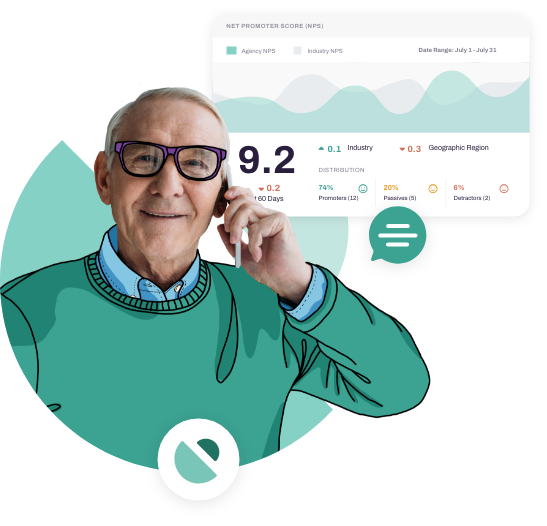The industry is expanding. Value-based purchasing is growing. The ability to stay nimble and responsive to clients are vital. Here’s how to stay on top of it.
The value of strong scheduling software is not lost on any home health care provider. This technology that bridges home office schedulers and care workers in the field is capable of bringing deep efficiencies to any operation, particularly if it’s flexible enough to evolve in step with your growth patterns.
But let’s take this article and go one step further with how we consider scheduling software. It is another strong, historical data-driven lens through which any agency can make strategic decisions. Deciding how to analyze data from inside this software can be incredibly revealing – and very effective if put to good use.
The industry is expanding. Value-based purchasing is growing. Efficiency and the ability to stay nimble and responsive to clients are vital. So, here we invite you to step inside your scheduling software – and view the top-5 metrics you should be watching right now.
#1: Utilization
The efficient performances of your schedulers and caregivers, even how quickly medical services are authorized by your insurance payers, are essential in uncovering current pain points as well as where future trends are headed. With the right software solution, utilization metrics can unlock a variety of insights that can be actioned upon swiftly and confidently.
Schedulers, for example, have their own unique demands and can vary greatly in their caseloads, from total hours worked and visits booked depending on their client scheduling load. The ability to pull reports that compare the average number of hours that all schedulers clock in order to determine if and where there are outliers can in turn prevent burnout and shift responsibilities to others who may have more bandwidth. Technology can actually make scheduling so efficient, it is possible to employ far fewer schedulers than in an agency managing with more rudimentary solutions.
Caregivers, arguably the most valuable asset of any agency, must be managed properly from recruitment and onboarding through to how many shifts they’re receiving, where, and when. Tracking their utilization properly can provide agency leaders real-time, quantifiable feedback into caregiver capacity and identify any red flags that could contribute to churn well in advance. For example: are some caregivers working overtime hours while others are not receiving enough shifts?
Lastly, when it comes to tracking payer/payor/billing authorizations, having a window into whether potential revenue is being lost (i.e. under-authorization), or if the maximum reimbursement rate is exceeded, helps account for every dollar while preventing administrative headaches down the road.
#2: Shift offers accepted
Shift offers to field staff should be automated, through the modern mechanics of home care software. This in turn makes the task of schedulers easier and reduces the amount of vacant, late, or missed visits that can occur and disrupt client care and satisfaction.
Shift offer functionality is a way for caregivers to access and accept available shifts in real-time. These would typically flow through mobile messaging alerts – giving caregivers the flexibility to pick up additional client visits if the timing fits that day or that week.
As we turn then to the data agencies can generate shift offer reports that go a step further and track the rates of acceptance and rejection by individual caregivers. This can illuminate a nurse or HHA who may be overworked or simply unmotivated – and managers can in turn be proactive about getting their schedules in better balance. Such metrics also become valuable from a human resources perspective, providing an audit of the number of additional hours offered, or even supporting misinformed unemployment claims.
#3: Margins
Financial departments understandably pay close attention to margins to ensure the profit to revenue ratio is sound. Here, metrics from the arena of scheduling can inform several reports with specific perspectives on how an agency is performing on many levels.
For example, it’s possible to pull gross margin reports complete with caregiver mileage and overtime hours. Or you could assemble margin reports for every single visit in a day or a week or a month. These metrics can offer a close lens on what client visits in any particular district or zone are costing at the margins of spreadsheets – where, over months and years, an agency’s bottom line is bolstered or weakened.
In today’s climate, many agencies are considering mergers and acquisitions as a strategy for growth. For those positioning themselves favorably to be acquired, the greater the margin, the greater the multipliers will be. So it’s important to ensure your software is sound in being able to quickly and intuitively pull the data you need to demonstrate your consistent value.
#4: Location or department performance
Tracking the total number of visits and hours of service can be about much more than electronic visit verification (EVV). If agency leaders have accurate intel on how a particular location or department is performing, they can proactively catch anomalies long before they spiral into thornier and chronic issues.
Scheduling metrics can be used to populate robust reports that reveal how each department or location is tracking, as well as specifics around HHA and nurse hours, and much more.
The more offices an agency has, the more valuable these metrics become, offering greater insight areas or specific services experiencing high or low demand. This in turn informs better business decisions that will have a tangible positive impact.
For example, if one location is getting less traffic than another, you can look to invest in marketing efforts or make different hiring decisions to boost performance. It’s also valuable to be able to look at these metrics on both a corporate level and an individual level, to see everything from revenue and where clients are being referred from to visit counts and hours clocked.
#5: Referral sources by client revenue
Gaining a holistic view of a client pipeline and referrals over months or years can offer an important look at exactly where your clients are coming from, when, and through whom. This is particularly valuable as it allows you to see what referral sources provide you with the best revenue across departments and/or locations. Knowing, for example, which hospital sends you the most cases – resulting in the highest number of scheduled hours – is a meaningful insight that can help you nurture that client pipeline further – or help determine how to boost revenue amongst other sources, too.
For example, are clients finding you online primarily via your website or through a search engine? Are family and friends or other clients themselves responsible for sending new business your way? Are health-care practitioners in the community sending clients your way? Why – or why not? Tracking the pace of new clients over time through your scheduling software can help you spot lucrative trends and make informed business decisions, ensuring full visibility into the revenue attributed to your network of care.
A treasure trove of information
Taking a deep dive into your scheduling software is imperative when it comes to ensuring your agency is sound both today and well into the future. With modern technology, look past the up-front utility of software applications, and see how captured data can be used to drive metrics and reports that keep operations humming, employees retained, and clients satisfied.
Here, we’ve pulled out the top five metrics to consider right now, but there are many more deep insights to be uncovered to help you make insightful decisions about your business. Check out AlayaCare’s robust guide for more information on how to make your data work smarter for you.







